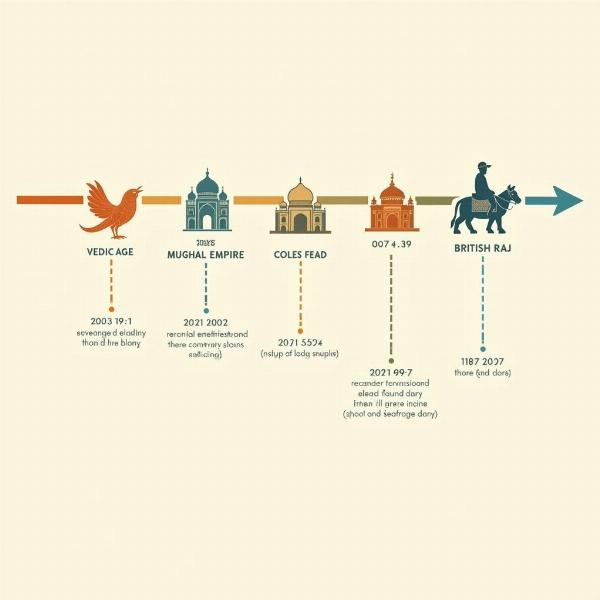Understanding the meaning of “periodization” in Hindi is crucial for anyone working with historical texts, literature, or simply seeking a deeper understanding of Indian culture. This concept, often translated as “काल विभाजन” (kaal vibhaajan), refers to the division of time into distinct periods, each characterized by unique features and developments. Whether you’re translating documents, studying ancient history, or just curious about the nuances of the Hindi language, grasping the concept of periodization can significantly enhance your understanding.
What Does Periodization Mean in Hindi?
“काल विभाजन” (kaal vibhaajan) literally translates to “time division.” It’s the process of categorizing history or any other timeline into specific periods, based on shared characteristics like political regimes, social movements, artistic styles, or technological advancements. This allows us to better understand and analyze the flow of time and the interconnectedness of events. Think of it like organizing a library – instead of having all the books piled together randomly, we categorize them by genre, author, or period to make them easily accessible and understandable. Similarly, periodization provides a framework for understanding the vast expanse of history and culture.
 Indian Historical Timeline
Indian Historical Timeline
Why is Periodization Important?
Periodization isn’t just about neatly dividing time; it’s about understanding the why behind the divisions. It helps us analyze historical trends, identify turning points, and understand how past events influence the present. For example, studying the Mughal period allows us to appreciate the influence of Persian culture on India, while the British Raj period explains the prevalence of English in the country today. By understanding these historical periods, we gain a richer and more nuanced perspective on contemporary India.
Different Approaches to Periodization in Hindi
Just like organizing a library, there are different ways to periodize history. Some common approaches include:
- Dynastic Periodization: Focusing on ruling dynasties, like the Mauryas, Guptas, or Mughals.
- Cultural Periodization: Emphasizing major cultural shifts, like the rise of Buddhism or the Bhakti movement.
- Political Periodization: Centered around significant political events, like independence or the partition of India.
Periodization and Literature
Periodization also plays a crucial role in understanding Hindi literature. By classifying literary works into specific periods, we can analyze the evolution of language, themes, and styles over time. For example, the “Adi Kal” (Early Period) of Hindi literature is characterized by heroic ballads and religious poetry, while the “Bhakti Kal” (Devotional Period) focuses on mystical and devotional themes.
Expert Quote: Dr. Anjali Sharma, Professor of Hindi Literature at Delhi University, states, “Understanding the historical context through periodization is crucial for appreciating the nuances and significance of literary works.”
Challenges of Periodization
While periodization is a valuable tool, it also presents challenges. Defining clear boundaries between periods can be difficult, as historical change is often gradual and complex. Furthermore, different perspectives can lead to different periodization schemes. Therefore, it’s important to be aware of the limitations and potential biases inherent in any periodization system.
Conclusion
Understanding “periodization” (काल विभाजन) is essential for anyone seeking a deeper understanding of Hindi language, history, and culture. Whether you’re a student, a translator, or simply a curious learner, this concept provides a valuable framework for navigating the complexities of time and its impact on the Indian subcontinent. By grasping the different approaches and challenges of periodization, we can gain a more nuanced and comprehensive perspective on India’s rich and diverse heritage.
FAQ
- What is the simplest way to define “periodization” in Hindi? It’s the division of time into meaningful periods based on shared characteristics.
- Why is periodization important in the study of history? It helps us organize, analyze, and understand historical trends and events.
- What are some common methods of periodization? Dynastic, cultural, and political periodization.
- How does periodization apply to Hindi literature? It helps us understand the evolution of language and themes over time.
- What are some challenges of periodization? Defining clear boundaries and avoiding biased perspectives.
- What is the Hindi word for periodization? काल विभाजन (kaal vibhaajan)
- Is there a perfect way to periodize history? No, as different perspectives can lead to different interpretations.
Related Articles
About Meaning-Hindi.in
Meaning-Hindi.in is your one-stop solution for all your Hindi translation needs. We offer a wide range of professional translation services, specializing in business, legal, technical, website localization, educational, and specialized translations. Our team of expert linguists ensures accurate and culturally sensitive translations that meet your specific requirements. Whether you need a document translated quickly or require specialized expertise, Meaning-Hindi.in is here to help. Contact us today at [email protected] or call us at +91 11-4502-7584 to discuss your translation project.